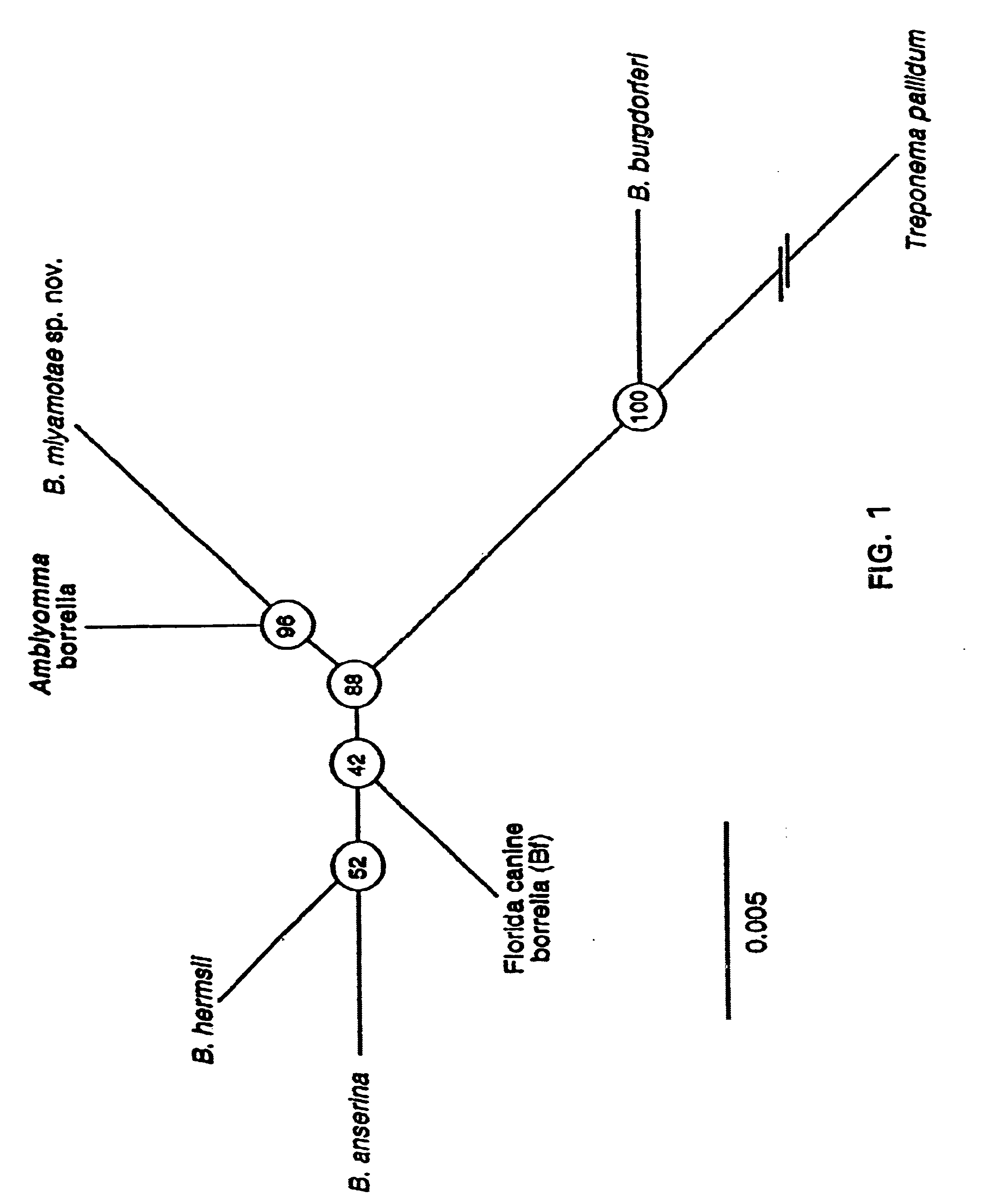Diagnostic test for borrelia infection
a technology for diagnosing borrelia infection and borrelia, which is applied in the direction of biological material analysis, peptides, drug compositions, etc., can solve the problems of no means of identification of new spirochetes, no means of diagnosis of infection, no compositions for clinical tests, laboratory assays,
- Summary
- Abstract
- Description
- Claims
- Application Information
AI Technical Summary
Benefits of technology
Problems solved by technology
Method used
Image
Examples
example 2
The A. americanum Spirochete is a New Borrelia Species, B. lonestara sp. nov.
The present example describes the inventors' analysis of the A. americanum spirochete that led to their determination that the spirochete is a new Borrelia species.
The present inventors used the polymerase chain reaction (PCR.TM.) and amplification of conserved genes using primers designed on the basis of sequences of possibly-related organisms (Relman, 1993). The genes for 16S rRNA and flagellin, the major structural protein of flagella, of several Borrelia spp. were available, and alignment revealed regions of genus-specific sequences.
A. americanum ticks were collected in New Jersey and New York from the field by flagging. Flagging is a technique described in Maupin et al., (1991) which reference is specifically incorporated herein by reference. A. americanum ticks from Texas had been removed from human hosts and submitted to the Department of Health. Ticks were dissected with sterile instruments, and por...
example 3
Regions of B. lonestari sp. nov. Flagellin Gene and rRNA Gene Sequences Differ From Those of Other Borrelia sp.
The present example describes those regions of the B. lonestari sp. nov. flagellin amino acid and rRNA sequences that differ from those of other Borrelia sp.
With the inventors' collection of evidence that the Amblyomma spirochete was a new Borrelia sp., sets of primers were used to amplify a larger region of the flagellin gene and most of the 16S rRNA gene. The primers were based on identical sequences in flagellin and 16S rRNA genes of Borrelia spp. The primers differed in sequence at two or more positions from homologous sequences of other spirochetes and bacteria. In the following primer sequences, the positions listed in parentheses refer to B. burgdorferi flagellin (Fla) and 16S rRNA (16Rna) genes:
FlaLL, 5'ACATATTCAGATGCAGACAGAGGT3' (301-324); SEQ ID NO:11
FlaRL, 3'TGTTAGACGTTACCGTTACTAACG5' (942-965); SEQ ID NO:12
16RnaL, 5'CTGGCAGTGCGTCTTAAGCA3' (36-55); SEQ ID NO:13
16...
example 4
A Fusion Protein Comprising a Portion of B. lonestari sp. Nov. Flagellin
The present example describes the placement of the nucleotide sequence represented by SEQ ID NO:1 into a construct to provide a fusion protein for immunoassay. This construct supplies an N-terminus and a C-terminus for the recombinant fusion protein. The PMAL.TM. p2 expression vector, obtained from New England Biolabs, (Beverly, Mass.) and encoding the maltose binding protein, was used for this construct. The vector was digested with EcoRI and XbaI, ligated to the nucleic acid having SEQ ID NO:1, and having an in-frame stop codon and synthetic EcoRI and XbaI sequences added; and the recombinant molecule transfected into E. coli JM103. Methods for protein fusion and purification are described in the New England Biolabs brochure (1992). The resulting construct is represented by the partial sequence of SEQ ID NO:26. A fusion protein is made that, when cleaved with a blood protease factor Xa, releases flagellin prot...
PUM
| Property | Measurement | Unit |
|---|---|---|
| pH | aaaaa | aaaaa |
| temperatures | aaaaa | aaaaa |
| temperature | aaaaa | aaaaa |
Abstract
Description
Claims
Application Information
 Login to View More
Login to View More - R&D
- Intellectual Property
- Life Sciences
- Materials
- Tech Scout
- Unparalleled Data Quality
- Higher Quality Content
- 60% Fewer Hallucinations
Browse by: Latest US Patents, China's latest patents, Technical Efficacy Thesaurus, Application Domain, Technology Topic, Popular Technical Reports.
© 2025 PatSnap. All rights reserved.Legal|Privacy policy|Modern Slavery Act Transparency Statement|Sitemap|About US| Contact US: help@patsnap.com

